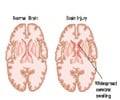In mice, the administration of LCL768 prevented secondary axonal degeneration associated with concussion, resulting in enhanced functional outcomes.

p17/C18-ceramide–mediated mitophagy is an endogenous neuroprotective response in preclinical and clinical brain injury
Go to source) In stressed neurons, p17 initiates production of C18-Ceramide, a bioactive sphingolipid that acts as a label of damaged mitochondria in neuronal axons. Labelled mitochondria are then detected and removed by autophagosomes. The authors knocked out p17 in mice.
Exploring Cognitive and Sensorimotor Impacts
Some p17-knockout mice underwent a new experimental model of repetitive concussive brain injury, known as the repetitive less-than-mild closed head injury (rlmTBI) paradigm. These mice developed significant sensorimotor deficits after three months. By six months, the mice had cognitive deficits. Control mice showed no behavioral impairments. In the rlmTBI p17-knockout mice’s brains, the authors found compromised and disarranged membranes in axonal mitochondria.‘p17 triggers the synthesis of C18-Ceramide, a bioactive sphingolipid that serves as a marker for damaged mitochondria in neuronal axons. #concussion #brain #Alzheimers’





In normal mice, these mitochondria would have been destroyed, but since that process was interrupted, the dysfunctional organelles persisted, and caused axonal degeneration, which in turn led to pathological outcomes. The authors developed a mitochondrial targeted pyridinium-ceramide analog drug, LCL768, which accumulates in damaged mitochondria and restores the process by which these organelles are removed. Finally, the authors examined human tissue from six neuropathologically verified CTE cases with a history of repetitive traumatic brain injury.
The CTE-positive samples exhibited less p17 expression and less mitochondrial C18-Ceramide than six age- and sex-matched healthy control samples. According to the authors, drugs that ensure a healthy pool of axonal mitochondria in the brain could be candidates for use as prophylactic treatments after a concussion.
Reference:
- p17/C18-ceramide–mediated mitophagy is an endogenous neuroprotective response in preclinical and clinical brain injury - (https://pubmed.ncbi.nlm.nih.gov/38328780/)










